#also inherently evil character go against some major elements of stranger things
Text
Some weird things I’ve noticed about one/Vecna/Henry - an incomplete list/analysis (also not excuses for all his shit, I’m just trying to figure him out)
I’d first like to start off by analyzing what we don’t see in Henry’s backstory. First, with Victor Creel, we are shown Vecna’s first attack through a very flawed lense. His father cannot see that his son was the one that killed everyone, not a demon. He doesn’t see Henry as the problem, but we also don’t see any other problems with Henry from his perspective. We don’t actually see much of Henry at all from Victor’s perspective. The thing I find interesting about Victors story is that he says that him and his wife were tormented by memories from their past. We get an explaination for his past, but we never see his wife’s past. Or at least we don’t get an explaination for it.
When we go to Henry’s version of the story, we get a whole lot of stuff that Victor didn’t know or care to mention. Like doctor Brenner, he didn’t come up in Victors story. Whether that be because of the plot reveal of Vecna or whatnot, he wasn’t mentioned. Henry made note of the fact that it was his mother that called in the doctor. Victor described Henry as a ‘sensitive child’ but when Henry said what his parents thought of him he said that they thought there was something wrong with him, that he needed to be fixed. We don’t get any evidence for them saying that, nor do we get them saying anything. Henry’s mother, who is shown more, is still not explained. She called the doctor and Henry described both parents as having dark secrets- but he never gave us his mother’s.
There are many many years we do not see with Henry and doctor Brenner. We can assume that after Henry went into a coma he was taken by Brenner and was with him for all the years until el banished him to the upside down. But we don’t see any of that. When does he get that tattoo in this time line? Is it before he murders his family? After? If it’s after, then what was the final straw that Brenner had that caused him to put that implant in his neck to suppress his powers? We don’t know. We’ve been given a lot, but we’ve also been given nothing. Why does Henry want to destroy everything? If it’s because he’s inherently evil and bad then that’s just boring. It adds nothing to the story or too the plot other than a cardboard antagonist put up for eleven to pour water on.
Henry is the main antagonist. He has been the main antagonist since the first season. The discussion of motivations throughout the series is always the first thing the think about. The why. Characters and trauma and secrets were a major theme in season four. Lies in season three. Deceit in season two. The unknown in season one. If Henry has been the overarching villain this whole time then he’s been connected to those themes this whole time.
Henry Creel isn’t a one dimensional character. His thoughts and motivations haven’t been established yet. Why four as a number, why his mother first, why the library, why not try to manipulate eleven further when she tried to save max, why was he a sensitive kid? Why is he the main antagonist?
A lot of season four was finding out who Vecna was. And they found out that he was Henry. But they didn’t find out shit about his motivations. It’s not Brenner, because Henry didn’t seem to care when el said he was dead. It’s not anyone he’s already killed because they’re dead. His motivations don’t seem to be in line with anything we’ve been shown yet. So, maybe his motivations lie with what we haven’t seen yet, Henry’s secrets.
We’ve only seen the consequences from Henry: His family, the children, the people of Hawkins. He’s manipulative, he’s powerful, he’s a whole super villain. But what is the cause? In everything we know about Henry, we’ve been given what he’s done. But everyone- even Henry- glosses over anything that might have been a cause. ‘I saw what my parents had done’ great, why’d he kill his sister before his father then? ‘He was a sensitive kid’, that’s not enough. Will was a sensitive kid, he didn’t murder anyone. He was different isn’t a strong enough explaination for his actions.
Henry is the way he is because of reasons that haven’t been explained in the story yet. And if his whole thing is absorbing people and their secrets so they can all suffer together, then he’s got secrets too.
#stranger things#henry creel#st vecna#st 001#long post#he’s and evil evil man with evil evil plans because- [redacted]#saw a post saying that he’s been evil since like birth and my brain went uhhhhh- no.#not in like a ahaha you’re wrong and incorrect#but because I truly believe that we haven’t been given shit#also inherently evil character go against some major elements of stranger things#billy could have been a terrible human from birth but they gave him a backstory that explained his character#he was a terrible human being BECAUSE- everything shown about his family#Steve’s redemption arc wouldn’t have been a thing if they were going will characterization like d&d alignment charts#lawful evil isn’t applicable to the shows previous characters and doesn’t really make sense to be brought in now
22 notes
·
View notes
Note
I’m sure you’ve already gotten a bunch of asks since Manny’s Crime King interview! I’m just like confused about him saying he’s enamored by her world but honestly like how is his different (besides his obvious commitment to the game) he lives in a nice loft, takes his kid to baseball, drives a fancy car, and plays tennis at the club. It’s not like he’s living the life of a thug. I guess I’m not getting the exact contrast of their worlds.
(Rest of my ask) I’m probably missing some obvious point here which is why I’m asking you lol helllppp
I do think Rio’s enamoured with Beth’s world, yes! I think that really boils down to the fact that while on paper Beth and Rio aren’t living dissimilar lives in terms of their roles as parents, and while they obviously now share parts of the criminal world, I do think the show is actually pretty specific in how it represents those worlds, particularly in terms of the masculine / feminine, and how a part of the curiosity around each other is in viewing one another as a key that both compliments their own world, while also unlocking the other’s one for them.
The gendering of spaces in storytelling – but particularly films and TV is, hilariously, a topic that I’m incredibly passionate about and have both written it a lot in my original work, and written about it a lot for magazines, journals and media sites (I’m actually writing an essay at the moment for a literary journal about LGBTQI cinema and how lesbian romances are highly domesticised [i.e. Portrait of a Lady on Fire, The Handmaiden, The Favourite, The Kids are Alright] while gay romances are usually very pointedly about keeping away from domestic spaces, moving and traveling [i.e. Brokeback Mountain, The Talented Mr Ripley, Moonlight, Midnight Cowboy, even Call Me By Your Name is heavily focused on being Americans abroad aka away from home] but that all feels like a different story, haha).
Luckily for me, Good Girls is actually about as obsessed with the gendering of spaces as I am. It’s a major, major throughline throughout the show for many of the characters, but particularly Beth and Rio, and their intrigue with the other’s spaces – her interest in his powerful, highly masculine one, and his with her deceptively innocent, strongly feminine one – is really central to their intrigue with each other more broadly.
So to talk about this, we probably need a little bit of context.
(Under a cut because this is literally 4,000 words)
Gendering Spaces in Cinema
It’s probably not a surprise to anyone here, but places and spaces in stories are about as gendered – if not more gendered – as they are in daily life. In particular, cinema’s visual and textual language has historically been very clear:
The inside is female. The outside is male.
This concept has really been around since the beginning of cinema but became very popularised through Westerns in the late 1920s onwards, and really underlined by war films particularly during propaganda cinema in WWII. Men are outside, battling the elements and other men, claiming land, building outwards, while women are at home – either literally or figuratively (if they’re actually out at war, like in the utterly fabulous So Proudly We Hail!, they’re at the ‘home base’ as nurses) – building inwards. Men protect the home while women create it.
Westerns feature these images very potently and very literally. Almost every single western dating back to the 1910s will have some combination of these two shots:
a) Woman at home, looking out into the wild:
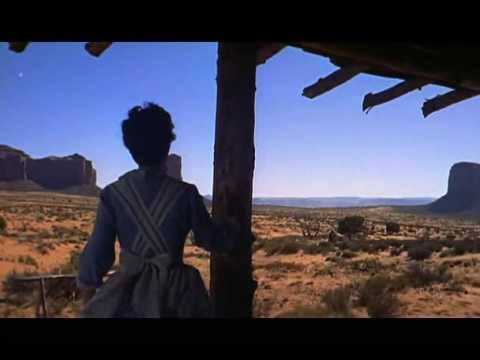
b) Man leaving home, stepping out into the wild:
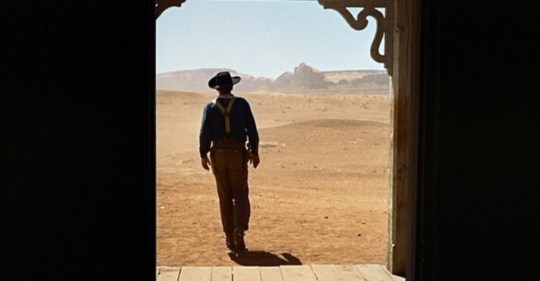
(These two stills are from John Ford’s The Searchers which is generally regarded as one of the greatest Westerns of all time. It’s………very racist and misogynistic, as many were and still are, but in terms of technicality and visual language, it’s a very well-made film, albeit not one I enjoyed).
The purpose at the time, of course, was steeped in historic sexism and invested in maintaining that culture, particularly westerns and war films which are heavily devoted to ‘macho’ narratives. Women were passive, men were active, but these images really set the stage for how the ideas of ‘space’ continues to exist in cinema. A fact that’s bolstered by broader social discourses that still exist today – schools, grocery stores, laundromats are inherently ‘female’ spaces because they are seen as an extension of the home, while police stations, car dealerships, warehouses, are inherently ‘male’ spaces because they’re about work, protecting and providing for a home, and being pointedly outside of that domestic space aka ‘the wild’. It’s not an accident that the girls are robbing grocery stores and day spas, but I’ll get back to that, haha.
These ideas of gendered spaces underpin everything we watch, no matter the genre.
Sure, these ideas can be subverted to varying degrees of effectiveness (often it’s steeped in my least favourite trope – the ‘not like other girls’ heroine), but you can’t subvert a trope without actually acknowledging it exists. Sometimes these subversions are done brilliantly too – like in Legally Blonde which was not just about Elle existing in a space that was quintessentially coded as male, but embracing her femininity and womanhood within that space; and often brutally too in films like Winter’s Bone, Room and The Nightingale which all brutalise women in ‘male spaces’ while simultaneously weaponizing female spaces against them – usually the home. The lead character of Winter’s Bone is going to lose her house unless her absent father shows up in court, the lead character of Room creates a home that is simultaneously a sanctuary and a mockery of a sanctuary to try and protect her son from reality and survive, the lead character of The Nightingale has her home invaded, her husband and baby murdered, and is horrifically raped within that home.
Hometown Horror: a divergence
This is a slight aside to where I’m going with this overall, but please indulge me, haha. I’m a big fan of horrors and thrillers, which explore this in a really stark way. In that, the invasion of a home or a domestic space – whether by ghost, demon or serial killer, is, generally speaking, synonymous with the invasion of a woman’s body and the violation of her as a person.
Films that focus on a female survivor or a ‘final girl’ are very generally focused on the invasion of her home as much as it’s focused on the invasion of her body. Think The Exorcist, Rosemary’s Baby, Scream, The Babadook, Hereditary, The Conjuring, Nightmare on Elm Street, Halloween, Panic Room. The violation of a woman’s home is the invasion of her, because cinema relies on over 100 years of movies telling us that a house and the woman who lives in it are symbolically the same thing.
Horror films that focus on men are very rarely centred in the home. It’s men travelling, or men visiting a woman’s home, or men who’ve been taken. Think of the first Saw movie which takes place in a mysterious basement, Hostel which is at a hostel, Dawn of the Dead at a shopping mall, An American Werewolf in London while two men are on holiday, The Evil Dead is in a cabin, Get Out is at his girlfriend’s family home.
There are exceptions, of course! Family home invasion films like The Purge, Funny Games and The Strangers are rooted in the violation of that home, but still. You’ll generally find that it manifests differently narratively speaking for men and women. Rear Window too takes place entirely in a man’s apartment – but it’s interesting to note that most of the ‘horror’ comes from him spying on somebody else’s home – notably a woman’s, The Descent too is very much about women and is set during cave diving. Still! These are all exceptions, not the rule.
Good Girls and Gendered Spaces
Every single space in Good Girls is gendered. It’s actually one of the things I seriously love about the show because it’s thoughtfully done, and it is deliberate. We know it is, because they tell us explicitly in the writing multiple times. I mean – hell, think of Ruby telling us (well, telling Rio, haha) way back at the end of 1.04 when they’re selling him on the idea of washing cash through Cloud 9 – “Nobody thinks twice about a woman buying her husband a TV or new tires for the minivan.” A store like that is gendered, and Ruby’s reinforcing it by saying it’s a place women go to build a home. It hasn’t been weaponized yet - - but our girls know how to weaponize it. They’re playing on the fact that people think women’s spaces are effectively impotent, and they’re telling Rio – and us as an audience – that they’re going to exploit it.
This is an idea the show revisits frequently. Women’s spaces are – both in life and in storytelling – spaces that are viewed as passive because they are representative of women, and what the show is – I believe – very invested in, is showing how those spaces are fundamentally active. If you want a house to represent a woman – well, okay. Then you get to see what’s under the rug, y’know?
I’m going to come back to the home thread – because I really do think it’s very important, and I think the way the show depicts people in those spaces (and invading those spaces) is significant – but it’s not just homes that are looked at in this way. The show is very specific about having feminine spaces and masculine spaces, with only a few in between (and usually those in-between spaces are very specifically for Stan and Ruby, showing just how in-sync they are with each other and how much they operate within a shared space). Beyond the women’s homes, there are the kids’ schools, Fine & Frugal (very important here to note that Annie emasculates Boomer in what is an associated female space and that he retaliates by attempting to rape her in her own home aka not only another female space, but a space that is symbolically Annie, something he repeats later with Mary Pat – a violation on essentially every character, narrative and symbolic level, again), the waxing salon, Nancy’s day spa, Jane’s dance recital (and actually the physical object of the dubby – being a highly feminine object lost in a very masculine space), and already what we know of s3, with Ruby being at a nail salon and Beth being at a paper / card store.
The show also has very masculinized places – I’d argue Boland Motors is one of the biggest ones – very much about ‘boys and their toys’, which is why Beth pointedly feminising it when she takes over is so significant and symbolically indicative of Beth’s claiming of that space; but also spaces like the police station, the drug dealer’s house in 2.07, the hotel suite Boomer briefly occupies, even to an extent the church. When the girls are in these spaces, there’s a distinct feeling of encroaching on territory that isn’t theirs, or being in spaces that they don’t belong in. This is often done as a two-hander too – the police station and the church Ruby doesn’t belong in anymore, not necessarily as a woman, but as a criminal.
Nothing though, from a technical standpoint, is more masculine than the spaces that are shown to be Rio’s. From the warehouse spaces to the bar to his loft to his car, Rio’s ‘places’ are distinctly masculine and generally placed in direct contrast with Beth’s femininity. But I’ll come back to that point too.
Home, Identity and Invasion
Almost every female character on this show has a very defined domestic space, from Beth, Ruby and Annie, to Mary Pat, Marion and Nancy. These spaces are representative of not just who they are, but who they are as women, and really comes to routinely represent the interior lives of these characters. This is probably the clearest in 2.09 when Beth is uncharacteristically messy following Dean taking their kids, and in 2.06, when Beth and Dean switch roles, and Dean is incapable of maintaining that domestic space because it’s not his. But let’s not start there.
Let’s start with Annie.
Annie’s apartment is fun, feminine (but not overly so), youthful, sweet, and generally a bit of organized chaos. It’s often underequipped – there are several mentions of the pantry being understocked – but it’ll always do in a pinch. More than anything though, Annie’s apartment comes to life when her son is in it. She’s happiest when he’s there, and when he’s not, her loneliness drives her to pulling people into the space with her, whether that’s the electronics guy, Greg, or Noah.
This is particularly significant when Annie’s forming bonds with people. The show has symbolically relied very heavily on Annie’s moments of vulnerability and connection being grounded in her apartment or an extension of it – usually her car. There was her reconnecting with Greg over YouTube videos in s1, there was Nancy and her talking about pregnancy in 2.02, and there was Noah settling in across season 2. These are all substantial moments in terms of Annie’s interior life that are represented through her home – she lets them all in. Which is why it’s significant what people do when they are in. Particularly the show marrying Noah getting to know Annie while simultaneously rifling through her belongings, trying to know specific things about her.
This is only reiterated by Noah’s scenes with Sadie later in the season – always at home, reiterating just how much Noah’s invaded Annie’s life, how much he’s inside her, how much he’s using everything and everyone who’s important to her, and how much he’s a threat to all of that too.
Ruby and Stan are a little different. Ruby’s house is the only one that’s genuinely shared with somebody, and the show represents this across the board – Ruby and Stan wear similar colours, the house feels like theirs, and the parts of their worlds that are separate are still frequently pretty defined by each other (even when Ruby’s acting away form Stan, the show makes it clear that Stan’s at the forefront of her mind, and vice versa). This indicates their partnership, but the house really still is symbolically tied to Ruby. This is particularly represented by the effect of having Turner in the house, but, more than that, it’s underlined symbolically by Turner arresting Stan at home. If the home symbolically carries the meaning of the woman, Turner arresting Stan there is starkly about Turner taking Stan away from Ruby. That image would not hold the same weight if he was arrested at, say, the park or the police station, because the locations don’t hold the same meaning.
It’s also why there’s significance in Stan and Turner’s showdown narratively speaking happening at the police station. It needs to, because symbolically it should occupy a masculine-coded space, because that showdown isn’t just about who they are as people, but who they are as men.
Beth and Beth’s house is very, very different to Annie and Ruby’s, and holds a more substantial narrative and symbolic function. From the very first episode, the potential of losing her house is key to her arc, and key to her identity as a character.
Beth is a lot of things, but a recurring image with her as a character is that she is invested in projecting a dated idea of ‘perfect womanhood’, and, within that, actually pretty perfectly creates parts of it for herself. For Beth – as somebody who was a housewife for roughly twenty years – her house really is her in every sense of the word. Every threat to that house, every disruption, every wrinkle, every intrusion, every theft, every invitation is personal. Dean might have at least two rooms in the Boland House, but that space is Beth’s on almost every symbolic level. When people pop into it, it’s a direct invasion of her.
This is something that the show has revisited time and time again, particularly when it comes to Beth’s bedroom. When people want to be close to Beth, that’s where they go. Annie slept there across season one when she was vulnerable and lonely, despite Beth telling her to go home, Jane broke into Beth’s closet there when she felt she was being neglected, Dean’s constantly trying to sidle into it (and – pointedly – only really in it when they’re fighting and Beth is revealing something / letting him in on something – that they’re out of money, that she has Rio’s money, that she knows about his affairs). When Beth has been at her most vulnerable, she lets Ruby and Annie into it. That said, the only character who’s been explicitly invited into it has been Rio – significantly both in fantasy, and in the show’s reality.
It’s not just about inviting people in though – when she kicks somebody out of it, the act is loaded.
She’s not just pushing somebody out of a space, she’s pushing them out of her.
It’s not just her bedroom of course (although I do think that’s the most significant space on perhaps the whole show). Rio and Turner between them have regularly invaded Beth’s living room, dining room, her kitchen, her yard. These are often distinctly tied with her doing something domestic and / or distinctly feminine. She’s bringing groceries home, she’s baking, she’s trying on jewellery, she’s mothering her children. Symbolically, this is often when Rio and Turner both are at their most masculine and their most threatening, which just serves to underline the invasion of Beth’s space.
It’s not just the girls though, as I said above. Female domestic spaces on this show are significantly coded as belonging to women, even if they share those spaces. Think about Nancy and Greg’s house – which is Nancy’s space, not Greg’s, and throughout season 1, Annie was pitted as the outsider to that. She’s a smear of hair oil on Nancy’s perfect couch. It’s made all the starker when Nancy kicks Greg out, and when Annie helps Nancy give birth in that house – a distinctly female, intimate act, that not only operates as a significant feminization of that space, but also about Annie fighting for Nancy to let her in again.
These spaces all keep secrets for the women they belong to too – Mary Pat’s husband’s dead body, Boomer’s very much alive one – because, again, symbolically, they are these women.
Rio’s loft is a really interesting one to look at in this context, because not only is it hyper masculine, but the show underlines that it does not hold the same significance that the girls’ places have for them. Beth does not learn Rio by being inside him – something made stark through their game of twenty questions. In fact, being in Rio’s loft, in his space, only serves to point out how much Beth doesn’t know him. Not only that, but Beth’s inability to lose her house (which is really central to her arc) is paralleled exactly with how easily Rio can separate from his.
The domestic space is not male.
Rio exists outside of it.
Beth x Rio and the Feminine x Masculine
Rio and Beth are basically at polar opposites of the masculine / feminine spectrum, and it’s something that this show often casts in a really stark light through dialogue, visual language, character coding and symbolism.
Beth epitomizes the old archetype of femininity and the female world in a way that I don’t think Annie and Ruby do (although I do think Ruby does in some respects). This is coded into almost every part of her character – from her long history of domestic servitude and marital submission (letting Dean control their finances, not working, keeping the house, etc.) to her fertility (four children!) to the way she dresses in floral, bakes, to certain traits, namely her nurturing tendencies, overt empathy and guilt (not being able to kill Boomer). Even in terms of the casting – Christina is somebody who has a very distinctly feminine body.
On the other hand, Rio, in many ways, epitomizes the old idea of masculinity and the masculine world. He’s coded that way almost as much as Beth is coded as feminine – he’s physically strong (beating up Dean, holding Beth up while they were having sex), assertive, dominant, capable and collected. That’s not even touching on the fact that the golden gun is incredibly phallic, haha.
The show loves to place Beth’s femininity in direct contrast with Rio’s masculinity in a way that it doesn’t do with the other girls or – in fact perhaps more notably – with Beth and Dean (if anything, Dean’s frequently emasculated around Beth, but that feels like a whole other thing, haha), and it does this frequently, and often even in the same shot.
Most notably, think of her pearls on the warehouse door handle:
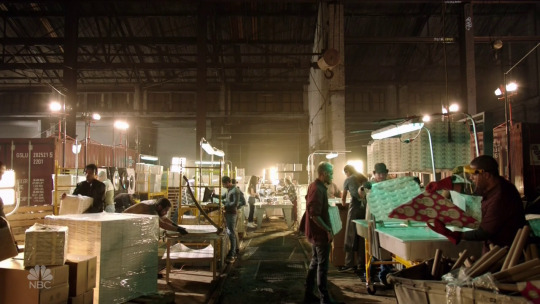
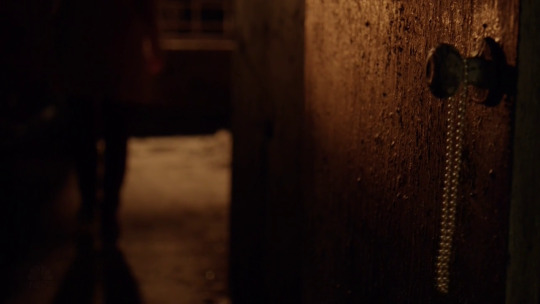
Their cars parked side-by-side:

Her necklace, his gun:


Her light, his darkness:

Her floral, his solid colours:

Interestingly though, these things are very rarely in competition or combative (although occasionally they are – Rio trying to use her femaleness and his maleness / their sexuality to literally bend her over a table in 2.06 being the clearest example of that). Generally speaking, the show’s visual language though shows us how these things compliment each other. They occupy different gendered spaces, so they can ‘crime’ in different ways – Beth using the big box stores, the secret shoppers, robbing the day spa, are all things that are highly feminised, and give Rio by proxy access to a world he ordinarily wouldn’t (albeit it’s not always a world he’s interested in – like it wasn’t with the botox), and the reverse of that is that Rio gives Beth access to spaces that are highly masculinised and that she ordinarily wouldn’t have access to (again, not always a world she’s interested in either). It’s why when they’re working together, and acknowledging they have different departments, they actually become something really whole, comprehensive and effective.
It’s the exploration of this that I find really intriguing generally, and particularly a thread that I think is reiterated where Beth’s usually at her worst and her most ineffective when she’s trying to emulate Rio’s masculinity. We saw that at the end of 1.10 and the start of 2.01, and I think we saw it at the tail end of season 2 too. When Beth’s succeeding, she’s typically doing something that revels in the strength and power and the underestimation of femininity and female spaces, and turns places that are typically viewed as passive into active ones.
The Secret Shoppers (which worked briefly! And fell apart because she couldn’t handle Mary Pat. Notably almost every scene with them was inside Beth’s house):
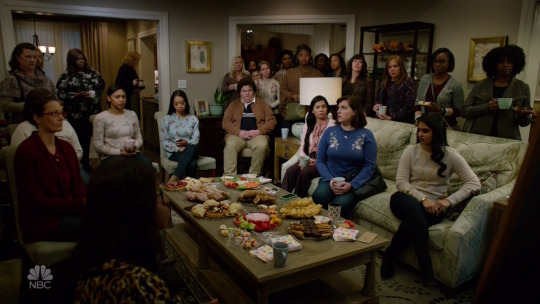
The day spa heist:

The Boland Motors takeover / reclamation that focused on feminising the place:

Pretending to be somebody’s mum to get into the kids’ space (which would’ve worked if Beth and Ruby hadn’t started fighting):
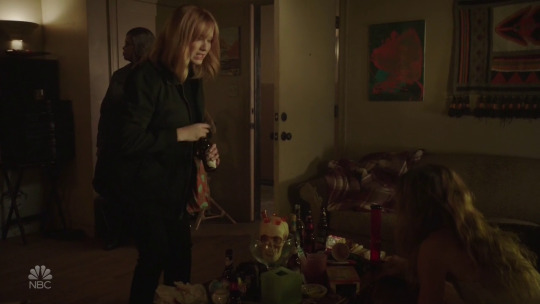
Breaking into Rio’s loft:

Again, this is something that seems to be being teased out already in s3 with the paper store and the nail salon, and I’m sure we’ll see it coming up again and again beyond that.
But yes! Your question, haha. I think Rio is enamoured with the strong, feminine space and the untapped female world that Beth exists in, and the ways that she is actively capable of utilising her femininity and her womanness in a way that is completely impossible for him. She can manipulate these spaces – either those already female, or those she makes female aka Boland Motors – in ways that he can’t, and in a way that, at the end of the day, lines his pocket, in the same way that giving her access to his powerful, masculine world lines hers. It’s market development, y’know? But it’s also something that could be a true and successful partnership if they could stop, y’know, playing games and trying to kill each other, haha.
I think it’s worth noting here too that the show has shown us explicitly that Beth absolutely gets off on Rio being highly masculine, and while I think Rio absolutely gets off on Beth being a boss bitch too, it’s also important to note how he responds to her when she’s displaying vulnerability in a way often defined as very feminine – namely crying – and how that display of femininity not only affects him, but often makes him want to touch her (and more and more, follow through on touching her).
Basically I think they’re as obsessed with the contrast between the two of them as we are, haha.
#beth x rio#gg season 1#gg season 2#gg season 3#set dressing#beth boland#rio#welcome to my ama#annie marks#ruby hill#stan hill#jimmy turner#nancy#mary pat#leslie peterson#boland motors#the boland house#the hill house#annie's apartment#rio's loft#femininity#masculinity
113 notes
·
View notes